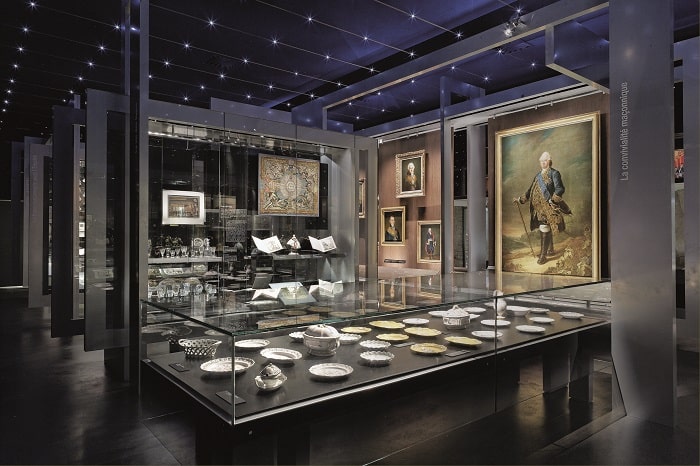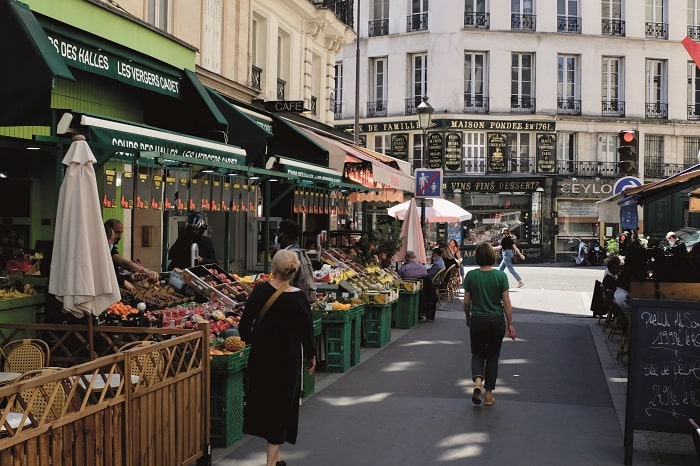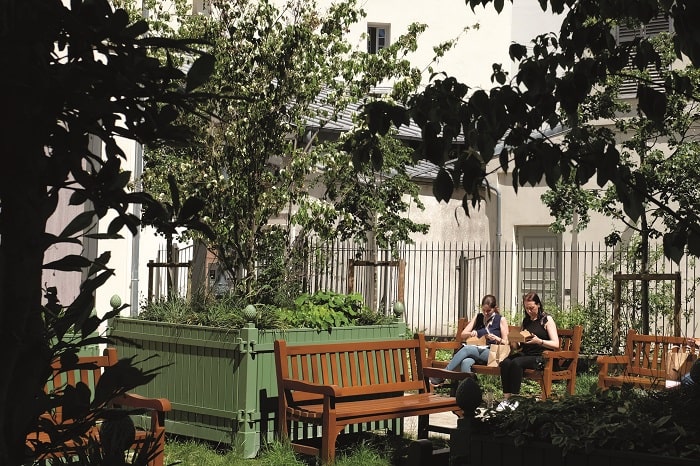Parisian Walkways: Rue Cadet in the 9th Arrondissement

It started life as a market garden and today is a secret haven for gourmands. Jeffrey T Iverson takes a stroll along Rue Cadet where he finds food, wine and history to whet the appetite.
For lovers of French food and Parisian cafés, nowhere are the charms of the City of Light so deliciously distilled as on its famous pedestrian market streets. Whether it’s Rue Cler (dubbed the ‘paradise of Parisian foods’), Rue Montorgueil (beloved by centuries of bon vivants from Casanova to Balzac), or Rue des Martyrs (now a launching pad for the trendiest food concepts in the capital), a visit to Paris isn’t complete without a stroll down one of its lively commercial walkways.
But one of the most captivating is one that’s easily overlooked – Rue Cadet. Perhaps a bit too far south of popular areas like SoPi (South Pigalle) and Montmartre, or a bit too far north of Palais Royal and Musée Grévin, Rue Cadet doesn’t appear on many tourist maps. But nestled in this lively corner of the ninth arrondissement, with its many office and residential buildings, and running 300m between Rue du Faubourg-Montmartre and the Cadet metro stop on Rue Lafayette, Rue Cadet is an oasis of fine food shops and sunny café terraces – a secret street reserved for locals and Parisians in the know.
“Rue Cadet certainly isn’t a major tourist destination, but the few who do venture here are always enchanted by this welcoming little quartier they discover,” says Martin Garros, head of the Rue Cadet business owners’ association. “You really are in the middle of the city: Montmartre, the Musée Grévin, the Grand Boulevards and many other tourist sites are all nearby, yet hidden in the centre of it all you have this little enclave of authentic Parisian life.” In fact, ‘secretive’ could be the leitmotif of Rue Cadet, for besides numerous fantastic under-the-radar food addresses, the street has also been home to several discreet and fascinating slices of society through the centuries, making it a delight for foodies and history buffs alike.
Rue Cadet originated during the reign of Charles IX, when two master gardeners named Jacques and Jean Cadet had the fine idea of transforming a footpath through a garbage dump (called Chemin de la Voirie) into well-fertilised soil beds for market gardens earning a fortune from melons, beans, lettuce and strawberries in the process. The street was named after them in the 18th century, when it began to be developed by aristocrats and entrepreneurs. Early among them was Claude Gallerand, Louis XV’s head of fruit production, who built a house at what became 9 rue Cadet.
In 1762, Jules-David Cromot de Fougy, one of Louis XVI’s financial advisers, acquired the house and transformed it into a luxurious mansion – the Hôtel Cromot du Bourg. In the early 1800s, Hôtel Cromot du Bourg became one of the most exclusive addresses in the musical life of France, when the renowned composer Ignace Pleyel opened a piano manufacturing plant at nº9.
In the 1880s, his son Camille, himself a famous pianist, transformed part of the hotel into a salon for concerts seating 150 people, which became known as the Salle Pleyel. Here, one February evening in 1832, Frédéric Chopin gave his first public concert in Paris, performing his Concerto in E minor, Nocturnes, Mazurkas and Variations on a theme from Mozart’s Don Juan. This intimate salon became one of the shy Pole’s favourite concert settings, and it was here he performed his final concert in Paris on February 16, 1848, in front the cream of Parisian society, including Louis Philippe and the royal family – who one week later would be ousted as part of the 1848 Revolution.

Musee de la Franc Maconnerie © Musée De La Franc-maçonnerie
The Revolution of 1848 and the rise of Napoleon III would indirectly lead to the creation of Rue Cadet’s most famous landmark – the Grand Orient de France (nº16), the largest, oldest Masonic organisation in mainland Europe. The French historian and Freemason Pierre Mollier explains: “After the coup d’état of Napoleon III in 1851, the French Freemasons, which had begun to be recognised as a group of liberals, Republicans and progressives, were suddenly afraid of being banned. So they chose a close ally of Napoleon III as their new leader – the Prince Murat, a mason who happened to be Napoleon’s cousin. It was Murat who, after more than a century, finally established a home for the Grand Orient, here on Rue Cadet in 1853.”
During the same period, the area around Rue du Faubourg-Montmartre, Rue Cadet and Rue Richer began welcoming waves of Jewish immigrants fleeing persecution in Eastern Europe. Still today, one finds numerous Jewish shops and synagogues in the neighbourhood, including Adas Yereim at 10 rue Cadet, inaugurated in 1893, making it the oldest Orthodox synagogue in Paris until its closure in 2014. In collaboration with exiled Armenians, they would transform the 9th arrondissement into the epicentre of Paris’s gemstone trade by the beginning of the 20th century, the Armenians primarily specialising in pearl and gemstone work, and Jews focusing on the trade.
An Art Deco façade overlooking a courtyard hidden inside nº14 reads “Société Immobilière des Perles et Pierres Précieuses”, a reminder of this prolific period, which sadly was cut short by World War II. The few jewellers remaining on Rue Cadet now ply their trade in workshops without storefronts, preferring a low profile. It’s understandable: just four years ago, thieves sneaked into a Rue Cadet diamond dealer during the night and stole a safe containing nearly 200 stones.

Rue Cadet’s food stalls © J T Iverson
Secretive by Nature
France’s Freemasons know well the difficulty of maintaining secrecy around their activities while also being engaged in public life. “Unlike the Masons in countries like England, where they have historically been more moderate and rarely engaged in politics, in France the Masons and the Grand Orient have always been active participants in political debates,” says Pierre Mollier. “From the moment Freemasonry arrived in France around 1725 they encountered hostility from the Catholic Church for advocating religious tolerance. Through the years conservative voices have painted the Grand Orient as the secret headquarters where liberals and progressives devise plots against traditional society. And as the Masons are secretive by nature, this idea that the Grand Orient is a seat of power in France has endured.”
During World War II, the Nazi propaganda depicted a ‘Jewish-Masonic’ conspiracy, and the Vichy regime dissolved the Grand Orient, leaving its Rue Cadet headquarters to decay. The building later had to be demolished, and was replaced by its present striking metallic façade in the late 1960s. Today, the conspiracy theories are becoming less prevalent, perhaps thanks to the Grand Orient’s efforts to bring the public inside, with a museum revealing everything from Voltaire’s Masonic robes and Lafayette’s Masonic sword to ancient texts that probe its mysteries.
“Freemasonry is very secretive, of course, but as early as 1745 there were books published for the public explaining its rituals,” says Mollier, who is curator of the Musée de la franc-maçonnerie. “The museum was actually created in 1889, but was completely renovated in 2010 as an official Musée de France. Our mission is to recount the history of the Masons and their contributions to France.”
The Masons have certainly contributed to life on Rue Cadet. “You may have more than 900 people attending meetings and such some evenings,” says Mollier. “And obviously many are the same people you’ll see shopping at the hardware store later on, buying bread at the boulangerie, or dining at the bistro.” Indeed, they’re all part of a Parisian village like no other.

An al fresco lunch in the the courtyard of the Hôtel Cromot du Bourg © J T Iverson
A Slice of Rural France
Up the street at nº20, Martin Garros, who moved to Paris six years ago from Gers in southwest France, to open an outpost for Maison Tête – his family’s artisan foie gras and cassoulet business still remembers when he first stepped into this little world tucked in between the 9th district’s busy boulevards. “As someone who grew up in the countryside, I felt like I’d discovered a little piece of rural France here, with the baker, cheesemonger, and butcher who all know each other, and many actually living above their shops. That creates a special dynamic, a degree of closeness and conviviality between everyone that is really rare.”
In Garros’s eyes, Rue Cadet has no reason to envy other more renowned market streets favoured by famous French chefs. “There are extraordinary products to be found on this street, which is also what drew us here,” he says. “As bon vivants and a family of artisan producers from southwest France, we feel like we fit right in on this little hidden street.” Today, Garros is surrounded by other artisans offering delicacies produced with as much care and savoir-faire as his own free-range duck confit.
At nº20, Fromagerie Beaufils boasts phenomenal raw milk cheeses from across Europe. At nº22, the wine shop Âme et Esprit du Vin offers competitively priced grand cru Burgundy, yet remains committed to promoting exciting wines from lesser known parts of France. At nº 18, the delicatessen and butcher’s shop Chez Seb et Marie satisfies a demanding clientele with 25-day dry-aged beef, award-winning truffled boudin blanc, divine quiche and other prepared dishes. And up the street at nº13, the bakery Maison Dupuy draws devotees of traditional French desserts with perhaps the most jaw-dropping tarte Tatin in Paris.
Over the years, this high-quality gastronomic environment has attracted a number of innovative food businesses, from the excellent Corsican pizzeria Papacionu at nº7 to the healthy eating/gluten-free boxed-lunch spot La Guinguette d’Angèle at nº7, proving that Rue Cadet can be a launching pad for new food ideas as well. “I love the trendy market streets like Rue des Martyrs, full of interesting concept stores and new brands,” says Jérôme Boulestreau, founder of Apertivus, at 9 rue Cadet, a chain of fine food delicatessens dedicated to feeding France’s new trend: gourmet, all-evening apéritifs dînatoires. “But I personally prefer the quality of life on Rue Cadet. It’s so charming and pleasant to stroll here, and the relations between business owners and their clients are so much more relaxed and friendly.”
Nowhere is that village atmosphere more palpable than at the street’s ebullient brasserie Le Royal Cadet (nº11). “Ça va, chéri!” the owner Lionel Pradal greets each new arrival – male or female! Like generations of his countrymen before him, Lionel is an Auvergnat (or, more specifically, Aveyronnais) who left the poor countryside to make his fortune in Paris in the bistro world, bringing his region’s cuisine, accent and earthy humour with him. “People would never imagine that a brasserie like Royal Cadet would be exactly like those you find in Auvergne,” enthuses Pierre Mollier, a regular client. “The same dishes, the same traditions!” Lionel blushes. “I think people like it here because in so many neighbourhoods the real bistros are all gone today. You can’t find that authentic bistro ambiance anywhere any more. So it’s special when you find a place like this, where we like a laugh and don’t take ourselves too seriously. There’s a real conviviality with our clients – even if some of them are idiots!” He playfully punches a client, laughing. Mollier smiles: “I think it’s amazing that today, in this globalised capital, we are still able to find places like this.” And now you know too – just keep it to yourself!
RESTAURANTS AND BOUTIQUES
LA GUINGUETTE D’ANGÈLE
7 rue Cadet
Tel. +33 9 82 41 03 63
The success of this tiny corner vendor confirms vegetarian and gluten-free eating trends have finally caught on in France! And with to-go lunch boxes of dishes like lentils with a sage and thyme goat’s cheese emulsion, cabbage vinaigrette, cherry tomatoes and bourrache (borage) flowers, plus ultra gourmand vegan or gluten-free desserts, La Guinguette d’Angèle makes healthy eating a pleasure. Bon appétit!
APERTIVUS
9 rue Cadet
Tel. +33 1 45 23 59 61
Today the traditional French aperitif has grown from peanuts and a drink into a full evening affair. And so this delectable delicatessen was created, offering fantastic charcuterie and sheep’s cheeses from Corsica, bellota ham from Spain, Kalamata olives from Greece, freshly made house hummus, artichoke dip and tarama, plus a fine selection of wines – all you need for your perfect all-night aperitif.
LE ROYAL CADET
11 rue Cadet
Tel. +33 1 48 24 84 40
At a time when the traditional French bistro has disappeared from many Parisian neighbourhoods, Le Royal Cadet remains as old-school as they come, from its jovial Aveyron-born owner and friendly staff, to its kitsch décor, its low-priced beers and drinks, and its hearty cuisine, including dishes like slow-cooked pork Carbonnade, leg of lamb, roasted veal Orloff, and beef Parmentier.
FROMAGERIE BEAUFILS
20 rue Cadet
Tel. +33 1 42 46 94 74
The Fromagerie Beaufils team has scoured France and beyond in search of exceptional raw milk cheeses, and today offers an array of French and European delights like no other in Paris, from France’s best artisan Roqueforts and chèvres, pungent Gaperons and cep-infused Camembert, to ultra-rare raw milk Stilton (or ‘Stichelton’) and Cheddars from the UK, and truffled farmhouse Gouda from Holland.
MAISON TÊTE
20 rue Cadet
Tel. +33 1 45 23 58 62
This speciality shop is the Paris outpost of a family-run company based in southwestern France dedicated to their region’s many delicacies, from cassoulet and duck confit to rillettes and foie gras. The charming patio is always full with gourmets come for lunchtime specials like pulled duck sandwiches, duck poke bowls and duck magret salads, or for an aperitif of foie gras and other duck tapas.
ÂME ET ESPRIT DU VIN
22 rue Cadet 75009 Paris
Tel : 01.42.47.00.38
At this wine shop the ‘spirit of wine’ is one that blends tradition and innovation, with a collection of bottles from top-shelf Burgundy, like Puligny Montrachet, to choice Rhône cuvées like Crozes Hermitage, excellent grower Champagne, and a plethora of wines from lesser-known areas like Corsica, Limoux, Les Landes or Les Terrasses du Larzac – plus a patio to enjoy a glass or two over a cheese plate! Santé!
From France Today magazine
Share to: Facebook Twitter LinkedIn Email
More in Food, food in paris, markets, Paris, Paris cafes, Rue Cadet
Leave a reply
Your email address will not be published. Required fields are marked *




REPLY